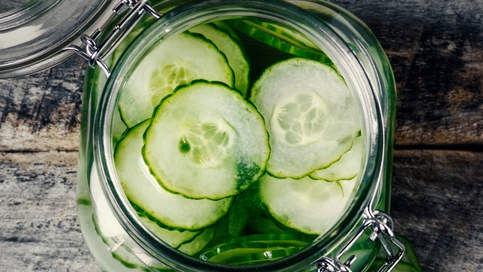How to Make a Quick Pickle–and Why You Should

A truism among chefs is that often something doesn’t need more salt, it needs more acid—whether that’s a squeeze of lemon or a dash of sherry vinegar. Often, in fact, it needs acid more.
The lovely thing with pickles is that they can add color, acid, and salt, all in one fell swoop. Consider the taco: A taco bar set with guacamole, lime quarters, tortillas, protein, and cilantro is great. One with chopped onions is a little better. But one with pickled onions? Now you’re at a restaurant, even if it’s only in your mind.
And those pinkish pickled onions you spy? They’re an absolute snap to make. You don’t need to turn on the oven. You don’t need to know about jarring and canning safety. Not for a quick pickle.
RELATED: The Homemade Pickle Popsicle Recipe You Need This Summer
I routinely pour a bit of red wine vinegar over thinly sliced white onions, adding a pinch of kosher salt, another of sugar, giving it a stir, and leaving it alone for 15 minutes to an hour. When I’m done with the rest of my taco bar prep, I come back to it, and voilà: pickled onions! (If you want a more formal pickled onions recipe that incorporates cucumbers, go here.) Pickles are a gorgeous way to amplify a meal. Got cheese and crackers? Set them out with pickled crudité and olives, and watch people lose it: You’ve just gone from home cook to certified genius.
As Hugh Acheson, chef and owner of Georgia restaurant Five & Ten, author of A New Turn in the South, and pickle guru, writes to Health, “If you want something to pickle fast, cut it more thinly.” (Acheson’s book has recipes for pickled green tomatoes, okra, and gingered carrots, among other things; the man likes a pickle.)
As for whether you’re going to need to turn on the stove and make a hot brine before pouring it over the vegetable—which tends to be the most perennial pickle preparation—he suggests you consider how you’d typically serve the produce in question. “Would you normally cook it? Hot brine. If you’d have it as crudité? Cut it finely and pickle at room temp.”
More pickling pointers to consider: You can pickle fruit! As Acheson writes, “I love pickled plums, simply done with a rice vinegar and sugar brine.” He’ll use them to garnish pork chops, but you could just as readily serve them with vanilla ice cream. Fruit presents an opportunity to cut out added sugar. “Remember that the sugar in most pickles provides balance,” writes Acheson. “If the fruit or vegetable is naturally sweet, you can cut it down or omit it.”
RELATED: How to Make Pickled Strawberries
Other tips? Things can pickle in seconds. “A fast sunomono of cucumber is literally a 30-second pickle,” writes Acheson. And you don’t always need salt, either. “Salt is needed historically as a preservative, and I believe in the maximizing of flavor using salt, but it is not necessary. Just better.”
As for choosing vinegars, if you use one in your pickling solution (you could also use hot water and salt), “any one works, but not traditional balsamic,” writes Acheson. “Cider vinegar is my most common medium.” And if you’re doing a quick pickle, for goodness sakes, don’t create huge hunks of vegetable that won’t pickle all the way through. The biggest mistake most quick picklers make, Acheson writes, is “they cut things too big.”
You don’t need fancy storage, either. “A clean jar with a lid works fine,” says Acheson. “They just need to be stored in the fridge.”
His basic brine and all-in-one pickling solution “that works for onions, cukes, whatever” is below. (Use something similar to make his bread and butter pickles.) Now hop to it, and get pickling.
2 cups cider vinegar
2 cups water
2 tablespoons pickling salt
1 tablespoon brown sugar
Alex Van Buren—follow her on Instagram and Twitter @alexvanburen—is a Brooklyn-based writer, editor, and content strategist who has written for The Washington Post, Bon Appétit, Travel + Leisure, New York Magazine, Condé Nast Traveler, and Epicurious.
